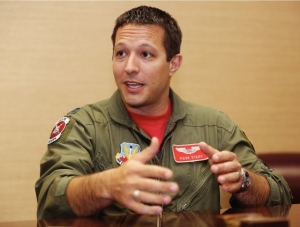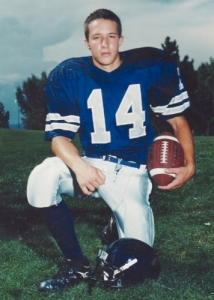Through the shots
By Joey Pitchford
Published in News on June 1, 2016 1:46 PM

News-Argus/CASEY MOZINGO
Capt. Tyler Stark, stationed at Seymour Johnson Air Force Base, talks about his experience at Columbine High School in 1999 during one of the first school mass shootings.

Submitted photo
Tyler Stark, pictured in his football uniform around 1999, played for Columbine High School and described his escape from the shooter Eric Harris as the "fastest 40-yard dash" he had ever run in his entire life.
Alone in a hallway at Columbine High School on April 20, 1999, Tyler Stark came face-to-face with a killer.
It was a day like any other.
Stark, then a freshman, was sitting down at lunch with his friends, Nathan and Brad. Another boy, Michael, came to sit down with them, but Stark's friends started giving him a hard time. He soon got up and walked outside.
Stark said that things began to go wrong shortly after that.
"The first indication that anything was awry was when Mr. Sanders came in the side entrance and told everyone to get down," he said.
"The table I was at was pretty close to the window, so I kind of went to the side and looked out to see what was going on, and that's when I saw Michael, who was the one who'd been sitting at our table just a few moments ago."
"It looked like he'd maybe fallen or something because his jeans were kind of torn and he was bleeding. It turns out he got shot in the leg and was trying to get away from the school."
Unbeknownst to Stark and his peers at the time, what marked the start of the chaos for them was part of a chain of events which had begun outside the school minutes before.
After propane bombs designed to collapse the cafeteria and kill everyone inside failed to explode, shooters Eric Harris and Dylan Klebold climbed the stairs at the west entrance to the school and began firing at students outside and in the stairwell. By the time Michael was hit, five other students had been shot as well.
Stark said that the reaction in the cafeteria was not immediately one of panic.
School violence at such a level was not yet part of the national awareness in the way that it is now, and Stark said that it took a moment to fully understand what was happening.
"I didn't really process that as a school shooting because that wasn't really a thing yet," Stark said.
"Then I see Dylan Klebold walking down the cement stairs with something in his hand. It looked like, maybe, a sand weight of some sort, but then he goes to light it and throws it into the parking lot."
Klebold was holding a homemade pipe bomb. The shooters threw nearly 100 of the devices before the violence ended.
Few of them fully detonated, which Stark said actually contributed to the confusion.
"I remember looking at the cars around where the explosion happened and thinking like, 'I don't see any damage, I just see a bunch of white smoke, this isn't that big a deal. Just, like, fireworks.'"
Stark said that Klebold then moved towards the cafeteria, prompting Sanders to yell for the students to get out.
After that nearly 500 students in the cafeteria made a collective dash for the door.
Jumping over chairs, weaving between each other and the tables, the wave of students crashed through the doors and spilled out in to the hallway. It was then, Stark said, that he heard the shooting start.
Stark had not grown up around guns. He said that, in the moment, his first thought was that gunfire sounded different than he'd expected.
"I expected it to be louder, but it was just rapid-fire -- pop, pop, pop."
Now running with Brad, Stark continued down one of the school's main hallways towards the exit. Stark said that there were teachers up and down the hallways beckoning students into their rooms, trying to keep them safe. Stark, for his part, kept right on moving.
"I was definitely in the 'flight' part of the fight-or-flight response, and there was still room to run, so I decided I would continue to run down that main hallway," he said.
And run he did; all the way to the exit, where he found a jam of other students waiting to get out.
With Klebold coming up the stairs behind them and beginning to fire down the hall, Stark said that he was not about to sit around and wait around for a turn at the door.
Instead, he turned down an empty side hallway which connected the two main halls, and started making his way towards another exit. Stark said that, at the time, he anticipated that other students would see that the direction he was moving in was clear and decide to follow him, thus clearing up the exit.
That particular tactic didn't go quite as planned. No one followed Stark as he ran down the hallway, which meant he was alone when he reached the end. And he was just as alone when he glanced around the corner and saw a dark figure standing around 40 feet away. It was Eric Harris, the other shooter.
For Stark, time slowed down. One-on-one with a gunman who would go on to murder eight people including Sanders, Stark's mind was moving faster than his body.
"He saw me and took a couple shots at me which were about 2 feet above my head," he said.
"It was more instinctual to turn around and start going the opposite direction. It's kind of like a cartoon, where the feet aren't getting traction yet, but you're still moving the other way. And I just started sprinting the way I came."
Stark, who played football at the time, described what followed as "the fastest 40-yard dash I've ever run in my entire life."
As he ran, images of various grisly fates that might befall him ran through his mind just as quickly.
"The thoughts that were going through my mind were, 'He's going to get around the corner, shoot me in the back and kill me' or 'He's going to shoot me, and I'll be paralyzed, and then he's going to walk up and finish the job,' or 'He'll shoot me, and I'll be injured, and he'll eventually get me.' Not very good outcomes, from the assessment that was going through my mind at the moment."
None of those grim expectations came true.
He made it all the way back down the hallway unscathed and left the school through the exit he had originally avoided joining a growing group of students at a park across the street.
With the shooting still in what would be its early stages, Stark said that he and his peers had not yet grasped the magnitude of what was unfolding inside the school.
"There were several hundred kids out there congregating. I saw a football buddy, and he said 'Man, this is all we're going to be talking about when we go back to class today'. No comprehension of what was really happening or the injuries and casualties of the day."
Stark then attempted to call home at a nearby friend's house, but he was forced to drop the phone and run after Klebold and Harris began shooting from out of the school at the gathered crowd.
No one was hit, but Stark and his friend decided it was time to leave. Jumping fences and running through yards, the boys tried to put as much distance between themselves and the gunfire as possible. When they eventually felt safe, they began the mile-long walk to Stark's home.
By the time Stark got there, the story had broken in the news. Family members called to see if he was okay, and he began what would be the first of many times telling his story.
The road to recovery was not an especially smooth one. Stark suffered nightmares, primarily of being chased and running for his life, for weeks after the attack. While the support of the community helped him come to terms with what had happened, it also struck a nerve with Stark, who grew angry at people who said they understood how he felt.
"They were trying to give me sympathy, but at the time it was like, you have no idea, you weren't there," he said.
"So you can't say that you know what I'm going through."
Although Stark wasn't particularly close to any of the students who were killed, going to the memorials and talking to his peers -- the people who legitimately did know what it was like -- proved to be helpful.
After visiting the school psychologist a few times, Stark was more able to accept the condolences of well-meaning community members.
Now a fighter pilot with the rank of captain at Seymour Johnson Air Force Base, Stark came out of his experience at Columbine with a greater appreciation for life.
This was compounded when Stark was forced to eject from his plane over Libya during the U.S. bombing campaign against Muammar Gaddafi in 2011.
He hid in a field until friendly Libyans found him almost entirely by chance. Stark's world view has been shaped by these narrow brushes with death.
"Especially after that, it's been that I'm very very lucky. I've had someone looking out for me."
"I really realized that you have to cherish the days you have, because whether it's friends, family, loved ones, coworkers, whoever, something you say to someone could be the last thing you say to them."
